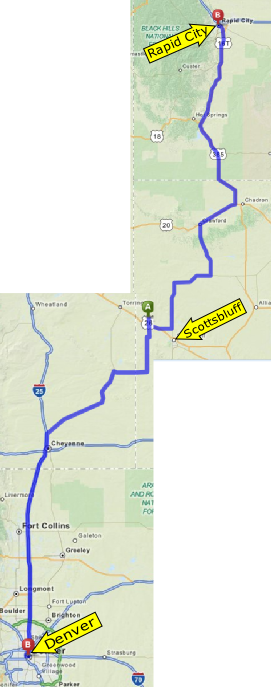
About Us
Location: On the Western edge of Nebraska,
406 3rd avenue Lyman NE 69352,
1 mile from the Wyoming state line,
200 miles North of Denver CO, and 200 miles South of Rapid City SD.
We just recently moved from the farm which Mary’s Great Grandfather
homesteaded in 1889 and which has stayed in the family since.
We got our first English Cocker in 1980. I had grown up with pointers
but living in a parsonage, in town, with a very small yard, the large,
very active dogs weren’t right for our situation. I researched to
discover what breed might meet our needs. Since I hunted mainly
upland birds and ducks, the English Cocker seemed worth a try.
Our first was a show bred, a lovely thing; she hunted, but had
some deficiencies, which had me looking for one bred to the gun.
As we searched out the availability of the sort of pup which would
fit the bill, we found the breed here was in a bit of a slump.
Field trials for cockers had not been held since 1964.
Many of the old hunting lines had disappeared. There were a few
scattered individuals working heroically to revive the working cocker
in the U.S. But it was hard to find field bred pups here.
I contacted the secretary of the English Cocker Spaniel Club of America.
Kate Romanski told me of a man not too far from us who had imported
a bitch in whelp from the UK. We bought one of those pups. Then when
we lost him we bought another from the same litter. Soon hooked on the
real, field bred EC, we later imported more. But the breed needed more friends. Few people in the U.S. had any idea that there was such of thing as a hunting cocker. I wrote letters to the Gundog editors of Field and Stream and Outdoor Life. I evidently piqued their interest because they both interviewed me and wrote articles about our dogs. Field and Stream’s Bill Tarrant in December of 1987 and Outdoor Life’s Larry Mueller in March of 1990. Bill also gave us some space in a couple of his dog training books. The articles sparked tremendous interest. More people got pups. More people imported good dogs. In 1993 the first Cocker field trial in nealy 30 years was held near ft. Collins CO. And the beat, as the song says, goes on, because these little wonders meet a real need. And admittedly, because they are cute and fun.

There is nothing original in our breeding philosophy. Form should follow function. Every dog has some characteristics which help and some which hinder its function. There are some characteristics which we prefer: Good sound legs, substance, a coat which resists burrs, enough coat for our tough winters, enough coat and fat cover to handle ice water happily. Short legged dogs and fat dogs tend to tire more quickly. I like ears to be without hair in the ear canal, to have a shape which does not draw grass awns toward the eardrum. I have found dogs too long in the back tend to herniated discs, too short and they tend to stress fractures in the vertebra, and an odd “rocking horse” gate. All that said, what matters in a hunting dog is the hunting. Just like the hunter who takes him afield, the dog can have all the right equipment and not function effectively. Attitude, heart, intelligence, drive, bird sense, and biddability, will always trump a practical coat, a muscular frame and straight front legs. If she puts more birds in the bag I’ll keep her around and see if I can correct her fiddle front or wooly coat in the next generation. If she is lazy, or rebellious or has no nose, there are too many better dogs in the country now to bother with her. I will have to admit, that all other things being equal, or nearly so, I prefer a cocker that is pretty, and unmistakably a cocker. I’ll hunt her 3 months out of the year. I still have to look at her the other 9. And, I’d rather not be asked if she’s a long haired dachshund, or a french Brittany.

